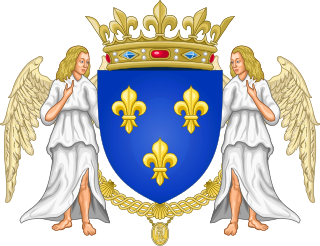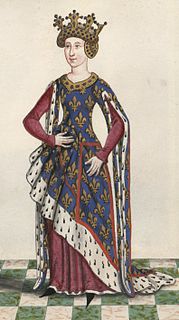The Capetian dynasty, also known as the House of France, is a dynasty of Frankish origin, and a branch of the Robertians. It is among the largest and oldest royal houses in Europe and the world, and consists of Hugh Capet, the founder of the dynasty, and his male-line descendants, who ruled in France without interruption from 987 to 1792, and again from 1814 to 1848. The senior line ruled in France as the House of Capet from the election of Hugh Capet in 987 until the death of Charles IV in 1328. That line was succeeded by cadet branches, the Houses of Valois and then Bourbon, which ruled without interruption until the French Revolution abolished the monarchy in 1792. The Bourbons were restored in 1814 in the aftermath of Napoleon's defeat, but had to vacate the throne again in 1830 in favor of the last Capetian monarch of France, Louis Philippe I, who belonged to the House of Orléans.

The House of Valois was a cadet branch of the Capetian dynasty. They succeeded the House of Capet to the French throne, and were the royal house of France from 1328 to 1589. Junior members of the family founded cadet branches in Orléans, Anjou, Burgundy, and Alençon.

Charles III, called the Noble, was King of Navarre from 1387 to his death and Count of Évreux from 1387 to 1404, when he exchanged it for the title Duke of Nemours. He spent his reign improving the infrastructure of his kingdom, restoring Navarre's pride after the dismal reign of his father, Charles the Bad, and mending strained relations with France.

Montmorency, pronounced [mɔ̃.mɔ.ʁɑ̃.si], was one of the oldest and most distinguished noble families in France.

John of Berry or John the Magnificent was Duke of Berry and Auvergne and Count of Poitiers and Montpensier. He was the third son of King John II of France and Bonne of Luxembourg; his brothers were King Charles V of France, Duke Louis I of Anjou and Duke Philip the Bold of Burgundy. He is primarily remembered as a collector of the important illuminated manuscripts and other works of art commissioned by him, such as the Très Riches Heures. His personal motto was Le temps venra.

The Grand Constable of France, was the First Officer of the Crown, one of the original five Great Officers of the Crown of France and Commander in Chief of the King's army. He, theoretically, as lieutenant-general to the King, outranked all nobles in the realm, and was second-in-command only to the King of France.
A Colonel General was an officer of the French army during the Ancien Régime, the French Revolution, the Napoleonic era and the Bourbon Restoration.

Isabella of Valois, Duchess of Bourbon, was a relative of the French royal family. She a daughter of Charles of Valois by his third wife Mahaut of Châtillon. She was the wife of Peter I, Duke of Bourbon.
The crown lands, crown estate, royal domain or domaine royal of France were the lands, fiefs and rights directly possessed by the kings of France. While the term eventually came to refer to a territorial unit, the royal domain originally referred to the network of "castles, villages and estates, forests, towns, religious houses and bishoprics, and the rights of justice, tolls and taxes" effectively held by the king or under his domination. In terms of territory, before the reign of Henry IV, the domaine royal did not encompass the entirety of the territory of the kingdom of France and for much of the Middle Ages significant portions of the kingdom were the direct possessions of other feudal lords.

Gilbert Motier de La Fayette Seigneur of La Fayette, Pontgibaud, Ayes, Nébouzac, Saint-Romain and Montel-de-Gelat was a Marshal of France and an ancestor of Gilbert du Motier, Marquis de Lafayette.

Margaret, Countess of Vertus, was a French vassal, Countess of Vertus and Etampes 1420–1466. She was the daughter of Louis I, Duke of Orléans, and Valentina Visconti.
John I, Count of Foix also known as Jean de Foix-Grailly was Count of Foix from 1428 until his death in 1436. He succeeded his mother Isabella, Countess of Foix. His father was Archambaud de Grailly.

Elisabeth of Bavaria-Landshut, nicknamed "Beautiful Beth", was an Electress of Brandenburg.
The name Dammartin-en-Goële comes from Domnus Martinus, the Latin name of St. Martin of Tours, who evangelized the region of Goële in the fourth century. A small town in the district of Meaux in the Department of Seine-et-Marne, ancient village of Region of Île-de-France, it appears to go back to the earliest times; Dammartin-en-Goële, also called Velly, was in 1031 one of the most significant places in France.